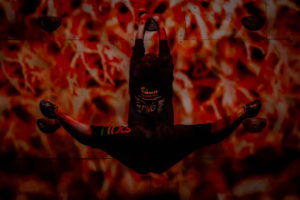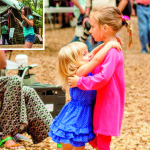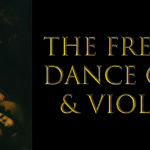An Upcoming Book that Examines the Frenzied Interrelationship Between Art and Violence
by David E. Gussak, PhD, ATR-BC
In March 2022, Oxford University Press will release The Frenzied Dance of Art and
Violence, my latest–and likely my last–book. A culmination of 8 years of work, this book will
explore what I believe to be the inextricable interrelationship between art and violence.
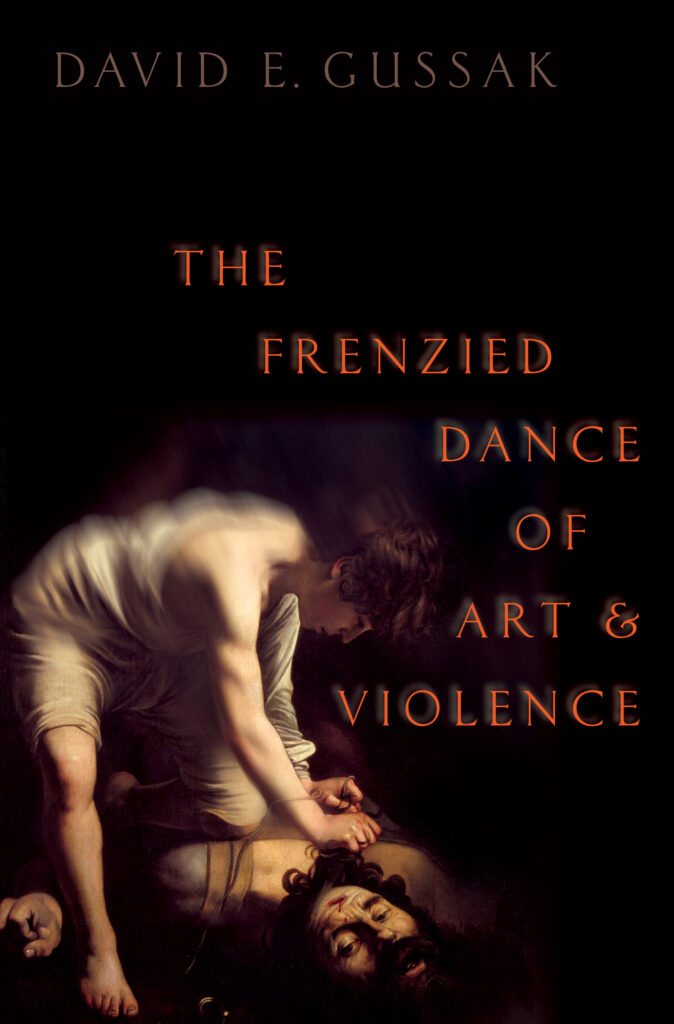
As an art therapist for thirty years who specializes with forensic populations, I have held
an unwavering conviction that the impulses and forces that drive violence and aggression may be
the same that drive one to create. Historically, many well-known artists have demonstrated
volatile, aggressive, violent—and sometimes even murderous–tendencies. It seemed to me that
those artists inclined towards violence–such as Caravaggio, Cellini and Dali– channeled these
destructive forces into their art. Some have created despite–or because of — overwhelming
societal conflict and violence that surrounded them, such as Goya, Beckmann. Picasso and Vann
Nath. Such creators used their art to help them make sense of, or gain power over their violent
circumstances. A number of heinous serial killers and multiple murderers drew and painted
works that society finds repelling and compelling. Yet it seemed that these atrocious offenders–
like John Wayne Gacy, Richard Ramirez, Charles Manson and Adolf Hitler– may have wielded
drawing and painting as a weapon, to mirror, even continue their psychopathic cycles. The in-
depth essays that make up The Frenzied Dance explores these disparate and numerous elements
to reveal and clarify these various interrelationships between art and violence.
The Dance Begins
In 2012 I was in the final stages of my book Art on Trial about my experiences
testifying as an expert witness on the drawings and paintings completed by a man being tried
for the murder of his child. During one of the many conversations with my publisher I told her
about lectures I recently gave in Las Vegas on paintings by the monstrous serial killer, John
Wayne Gacy.
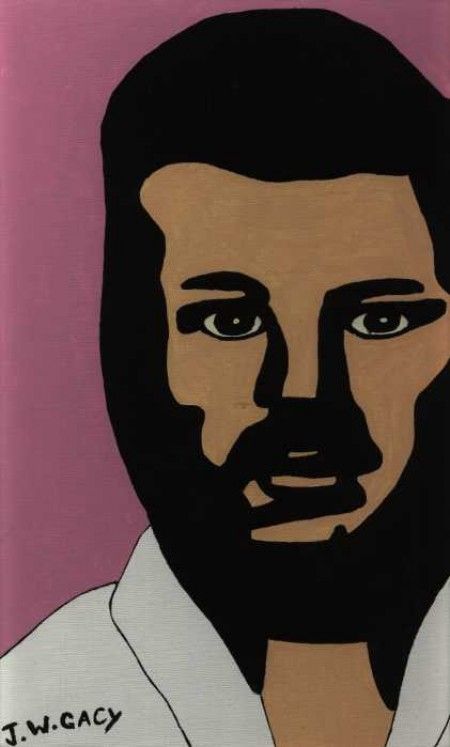
John Wayne Gacy 1 (b. 1942; executed 1994). Self- Portrait (Date unkn.). Oil on canvas board. Permission provided by Jim Taranto.
John Wayne Gacy (b. 1942; executed 1994). Death of Pogo (Date unkn.). Oil on canvas board. Permission provided by Jim Taranto.
She was fascinated. Indeed, she was surprised –as many people are–to learn that a
number serial killers have drawn and painted. As a result, and as any good publisher might, she
saw a book in this. She suggested that perhaps my next project could focus on the art of serial
killers. While I was averse to providing a single book on what I felt could merely be a
voyeuristic endeavor, a seed was planted, one that would grow into something well beyond the
paintings of such multiple murderers. I was compelled, almost driven, to go beyond this prurient
examination, to discover and deeply explore the potentially explosive and dynamic
interrelationship between art and violence.
Charles Bronson/Charles Salvador (b. 1952). Bronson- 1314- LIFE (2004). Pencils, colored pencils, and ink on paper. Permission provided by the artist.
I gained further insight into the phenomena of murderabilia after connecting with a
Berlin-based collector of the art of serial killers. And through it all I met with clinicians,
sociologists and artists for their insights and perspectives. From all this, I began to conceive of
this dance.
Just what kind of Dance is this?
At first, I saw this interrelationship as a tango; a constant, vigorous interplay between two
entities, one leading, the other following, then switching directions. Yet, the original premise
was built on the assumption that there were only two movements – violent energy driving the art
and art turning aside the violence. In my vision, sometimes art would lead and then sometimes
violence would; their interplay would remain harmonious.
Yet it gradually became clear that this was simply not the case. Despite my best efforts,
the idea of it being a symphonic dance did not hold up at all during the years of research and
writing; what emerged was something much more complicated.
As the chapters evolved, I began to realize just how convoluted this interrelationship
really is. While in some ways what I uncovered seemed to strengthen my already existing
beliefs, in other ways new insights replaced previously held assumptions. My original vision
began to shift, different truisms made themselves apparent, and a different project than originally
envisioned evolved. This dance was not held between two entities–it was amongst several
forces, perhaps changing partners, perhaps changing directions, perhaps all dancing together,
frantically, with great deal of fervor.
Indeed, art does seem to result from the same drives as aggression. It seemed the same
libidinal and narcissistically-driven forces that compelled Caravaggio to murder, Cellini to rape,
and Dali to assault, was the same energy that drove them to create incredible bodies of work.
Still, others suffered from inner demons whose control was impeded by alcohol, narcotics
or neurological impairments, that when combined with their own anxieties, doubt and unresolved
neuroses, resulted in uncontrollably volatile actions. For people like Pollock, Modigliani and
Dadd, who’s aggressive acts may have been instigated by such impediments, art seemed to
provide an effective–albeit brief at times– means to contain and redirect these impulses.
Even still, for all of the artists included in this text, their proclivities did not occur in a
vacuum: in many cases, they were further informed, driven, and even encouraged by the social
and political contexts of the times in which they lived and created. Yet, regardless of where the
aggression and violence derived, the artists’ creativity seemed to be fed from their libidinal and
aggressive drives, which, in turn, could diminish or even assuage their destructive tendencies.
Simultaneously, their art may have resulted from their need to cathart, sublimate, or contain their
aggressive inclinations.
In other words, their art was a way to wrestle with and even cage their hidden demons.
In many cases, art seemed to provide a means to regain control, re-humanize, re-
empower, maybe even escape for those affected by societal and cultural violence. There are
those like Picasso, Goya and Beckmann who illustrated the horrors of what they saw as a means
to make sense of it, to bear witness of the atrocities as a warning of what we are capable of. For
those who were unwilling pawns and the targeted sufferers of war such as Nussbaum and Vann
Nath, art provided a way to take back the control that was so violently snatched from them– to
lift them above their destructive, dehumanizing victimization while providing evidence of what
had befallen them. Even still, artists experiencing civil exploitation and volatility, either as
sufferer–such as Bill Traylor–or witness–like Norman Rockwell, used their talent as the only
weapon they had to stand up, fight back, and maintain their own identity and integrity.
However, when I began to deeply examine the disturbing histories and drawings of the
multiple murderers and serial killers, I was stumped. In full disclosure, these examinations
remained some of the most difficult to write as I tried to balance respect for what we can learn
from these perpetrators while not glorifying them. I had to examine my own desire to write about
them which I knew might still excite a certain subset of readers. Simultaneously, as I became
more embedded in these murderers’ backgrounds, I found I was oscillating between
desensitizing myself to their horrors and becoming overwhelmed, depressed, and anxious about
the inhuman nature of their crimes. It was also confusing; unlike many of my clients and the
artists presented earlier, it seems that these men would not nor could not benefit from the art
making: in fact, the work they produced and what it represented for them shattered my
previously held beliefs on the benefits of art making for those who are violent and aggressive.
Lee Boyd Malvo (b. 1985; remains incarcerated). The Prison Well Made by Mind (Date unk.). Pencil, ink on paper. Collection of Mirko K. Permission and reproduction provided by from Mirko K.
Glen Edward Rogers (b. 1962; remains on Death Row). Untitled (Date unkn.). Colored pencil on paper. Collection of Mirko K. Permission and reproduction provided by Mirko K.
Charles Manson (b. 1934; died 2017 of natural causes in prison). Shoes (Date unkn.). Oil on canvas board. Collection of Ken Dickerson. Permission and reproduction provided by Ken Dickerson.
Most of them did not begin drawing and painting until they were already arrested and in
prison for their heinous acts. Taking advantage of society’s fascination with such artefacts–with
murderabilia–they made sure that they remained visible to others. None of them seemed to
channel their violence and murderous ways through the art nor did the art seem to turn aside their
violence. Actually, what seemed to emerge was that the art was used as a weapon once they were
imprisoned to continue and perpetuate their wanton destructive patterns and reinforce their
narcissistic cycles from whence their violence originated. Once this realization materialized, it
became clear that I could no longer imagine it as a simple dance made up of two partners.
This realization informed my ability to deconstruct the enormous differences between the
opposing sides of one particular global atrocity, The Holocaust. On one side is arguably the
worst multiple murderer of all time, Adolf Hitler. As a painter, he engaged in his own
narcissistically-driven, dispassionate endeavors; as a ruthless dictator, he used art as a weapon
against his targets. Then there are those who suffered at the hands of the Third Reich. These
artists demonstrated remarkable evidentiary and rehumanizing creations. The comparison lays
bare the stark disparities, emphasizing the vast distance between inhumanity and humanity
through works that emerged from aggressive self- aggrandizement and the art that was birthed
from the desire to be seen and made whole.
All of this culminated in revealing the vast array of how art may be used to pursue peace,
reconstruct new identities and redirect and overcome aggressive and violent energy. Ultimately,
in short, how creating can facilitate change–through spontaneous art making, art education, and–of course–art therapy.
Through all this, a new overarching perspective became abundantly clear; no longer
could the image of a simple dance made up of two partners capture the complexity of this
interrelationship between art and violence. It is much messier, frenzied, feverish, and chaotic.
Perhaps a tarantella?
Final Thoughts
Ultimately, as I concluded in the Epilogue, in the process of researching for, reflecting on,
and writing this book, two seemingly antithetical and counterintuitive notions emerged:
- Aggressive and violent impulses are not always bad
- Art making is not always good.
Many of society’s laws and therapeutic interventions seem to be built off the premise that
aggression and violence are to be avoided or eradicated. This is easy to understand. My primary
experiences have been with violent offenders whose very actions have been crimes against
people and property, often because of misdirected impulses. Inherent in these systems is the
propensity to place negative and long-lasting labels on those that engage in such tendencies.
What has naturally emerged is the common belief that violent expression and aggressive
impulses are destructive and counter-productive.
Some examples illustrated in several of these chapters provided scenarios in which
violence was indeed detrimental to themselves and others. For example the actions of the
multiple murderers and some of the established artists like Caravaggio, Cellini and Dali. They
demonstrated how unchecked actions emerging from narcissistic cycles can be harmful and
dangerous. There are those whose destruction emerges from impulsive reactions to situations that
arose from diminished control due to substance use or neurological impairment such as Pollock,
Modigliani and Dadd.
However, as the book’s opening chapters argued, aggressive energy may also be a
valuable and beneficial force, from which change can occur and creative expression arise. Such
forces can and will contribute to actions that may overcome adversity and resolutely resist
limitations. Societal protest against injustice–such as the French Revolution, the Civil Rights
and Suffragist movements, or the recent Black Lives Matter– rely on aggressive pushback and
violent demonstrations to instigate change.
Artists such as Goya, Picasso and Beckmann relied on their aggressive and retaliatory
impulses against the injustices they witnessed and experienced to create monumental works of
expression. Rather than let the violence against them erase them from the world, those like Vann
Nath, Traylor, Nussbaum, Nowakowski and Haas used their art to fight back, with works that
would long outlive them. While not always socially acceptable they have been socially
productive. Aggressive energy, sometimes revealed either through impulsive or calculated
violent expression, becomes a drive, and when sublimated properly, can be instrumental for
change, development and creativity.
Guernica Children’s Peace Mural Project. Children of Tallahassee. Paint on canvas.
Permission and Reproduction provided by Dr. Tom Anderson.
On the other hand, art making is not always good. Recognizably, this runs counter to
beliefs that I have embraced and relied on since becoming an art therapist. Sometimes, art
making may not always be the balm that we would like it to be. It doesn’t magically transform
everything into good. Make no mistake. Art is never benign, innocuous or insignificant. It is a
powerful, potent and sometimes dangerous tool that can be used–to alleviate or magnify–
violence and aggression. Who uses this tool determines whether it is constructive or destructive.
Art is and remains an extension of the creator. As I indicated in a previous publication, for some
“art becomes the great equalizer, humanizing those that have been previously dehumanized.
Only when someone creates are they recognized as being alive”. Contrarily, for those who wish
it to be, art is a dangerous and malicious weapon.
Clearly, the examinations in this book are far from complete. There is much more
exploring and reflecting that can occur about the interrelationship between violence and the arts;
and not just visual art, but music, dance, writing and drama as well. Yet, I believe that as
preliminary conversation starters, these chapters have satisfied, informed and solidified my own
realization of the relationship between art and violence, and that there seems to exist a distinct
and clear interdependence and co-reliance between art and violence. Indeed, the messy, complex,
frenzied dance continues unabated.
One Final Note
While finishing this book, major changes began to occur around the United States and
the world. We were hit consecutively by violent and aggressive events that rocked the physical,
social and cultural fabrics of our nation– the advent of COVID-19 followed by the Black Lives
Matter movement. While neither were fully explored in this book, they both loomed large within my own psyche. Along with all of the fear, anxiety, helplessness and anger that global citizens
experienced were the creative responses that many of my colleagues and friends used to address
these violent upheavals. The power of art became apparent, providing various mechanisms to
address and adjust to the changes. Various forms of artistic expression were used to make sense
of all that was happening, escape from immediate anxiety and fear, and as a weapon against
injustice, ignorance and anger, while providing opportunities for burgeoning hope and
gathering strength.
While this book presents historical accounts, these events reminded me that the frenzied
dance never stops.
All images are borrowed from the upcoming publication, The Frenzied Dance of Art and Violence and
remain under copyright by the publisher and the author.
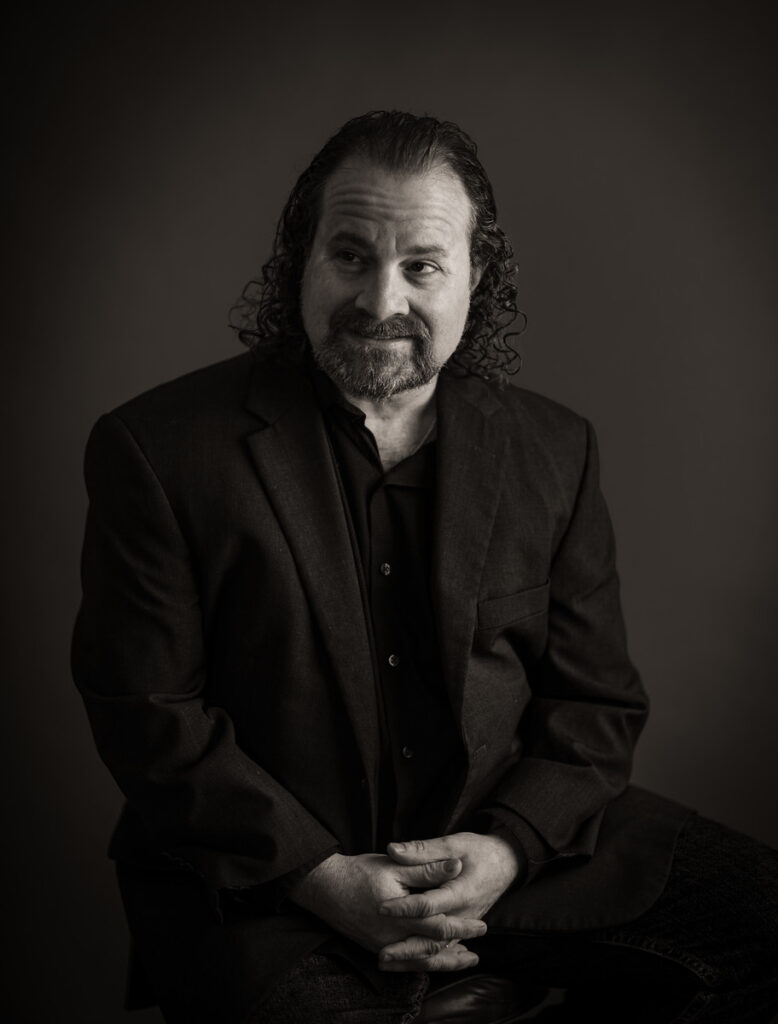
David E. Gussak, PhD, ATR-BC has been a Professor for the Florida State University’s Graduate Art Therapy Program for 20 years. He also helped develop and institute the FSU/FL Dept of Correction’s Art Therapy in Prisons program, for which he serves as its Project Coordinator. As an art therapist for almost 30 years, Dr. Gussak has presented and published extensively internationally and nationally on a number of topics, but most particularly on forensic art therapy and art therapy in forensic settings. Along with a number of journal articles, book chapters and edited volumes, he has also writtenArt on Trial (Columbia University Press, 2013) and Art and Art Therapy with the Imprisoned (Routledge, 2019).
He is also the co-editor, with Dr. Marcia Rosal, and contributing author for The Wiley Handbook of Art Therapy (2015). He is currently on the editorial board for Art Therapy: The Journal of the American Art Therapy Association and Arts and Psychotherapy, as well as a guest editor for several other journals, including The International Journal of Offender Therapy and Comparative Criminology. He lives here in Tallahassee with his wife Laurie and his son Joseph; his daughter lives in the great white North of Canada. After all this time, he still loves what he does, and still can’t believe that he gets paid to do it; still, despite this, given his distaste for writing, he stresses that The Frenzied Dance of Art and Violence (Oxford University press, 2022) is his final book. Really. He insists.




